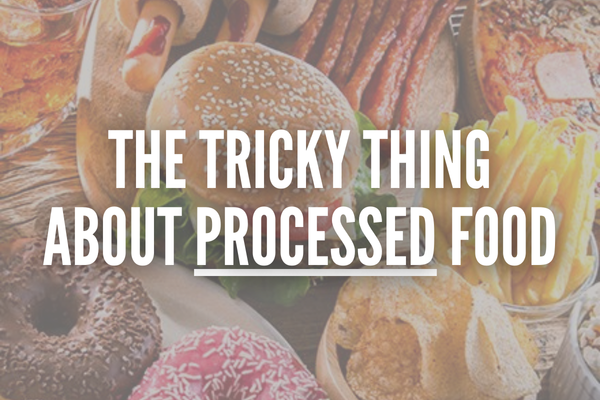Processed foods are easy to come by, but they aren’t easy on our health. So what is it about processed food that might make it harder to reach your health goals?
You Eat, But You’re Not Really Full
In research studies comparing a diet rich in processed foods versus low in processed foods, the folks who ate the processed food diet ate on average 500 calories more per day. But why? There are a few factors that contribute to this:
- Highly Processed foods lack fiber and protein. Fiber and protein are what help tell your body you are full.
- Highly Processed foods are often quick to dissolve (think of a chip or cracker, quickly dissolving in your mouth, and therefore, in your stomach). It might look like a lot of volume when you pour chips into a bowl or take a handful of crackers, but once they reach your stomach, there’s really nothing there to fill you up.
You Eat, But You’re Not Really Nourished
Our bodies are pretty amazing. However, our body doesn’t know, or care, what a calorie is. That is a human concept, but not something written into our biology. Our bodies know nutrients. Meaning, our body is always scanning and asking “do I have enough of this nutrient? enough protein? enough of this vitamin?”. If we’re running low in specific nutrients, then our hunger levels stay high, to help our body continue to search for the food and nutrients we need to function optimally.
Most processed foods are empty of essential nutrients, so we eat (and eat, and eat) them, we get lots of calories, but we are still hungry because we aren’t actually nourished. Our brain and body then sends out a messaging saying “That was delicious, but I still don’t have enough protein/vitamins, so you should keep eating”.
By aiming for a variety of real foods, including different kinds of protein and plant foods, like colorful fruits and veggies, beans, nuts, seeds, and grains – we give our body plenty of nutrients, vitamins, and minerals. Don’t worry if you’re a picky eater, even a small variety of animal and plant foods is enough. Real food fills you up, nourishes your body, and reduces the risk for health complications.
How to Spot Highly Processed Foods: Sourdough Bread vs. Sourdough Bread
When shopping, take a quick peak at the ingredient list of your favorite items. There might be an opportunity to switch out your household staples for better quality, less processed foods.
The first bread below is from the bakery of the grocery. It cost $2.79 for a loaf, and you can have it sliced for free. The second bread also comes from the deli/bakery area, but is in a bag, already sliced, and baked offsite. It cost $4.79 per loaf.
| Sourdough Bread #1 Ingredients | Sourdough Bread #2 Ingredients |
| Whole grain wheat flour, water, sea salt. | Unbleached enriched flour (wheat flour, malted barley flour, niacin, reduced iron thiamine mononitrate, riboflavin, folic acid), water, yeast, sugar, soybean oil, contains 2% or less of each of the follow: wheat gluten, salt, cultured wheat flour, calcium sulfate, acetic acid, vinegar, ascorbic acid, enzymes, wheat starch, xanthan gum, soy lecithin, calcium propionate. |
Not All Processed Foods Are Bad
There are a lot of terms out there for processed food. You might hear, or read, the terms “Ultra Processed” or “Highly Processed”. But, there is a category of processed foods that you might want to take advantage of. Think of frozen veggies, canned beans and produce, lean ground turkey, a no-sugar added jar of marinara sauce or salsa – ingredients that help make a homemade meal come together in a pinch.
While these foods have been through some level of processing, but they are still pretty close to their natural form, and they reduce the work you have to do. These lightly processed foods can help you to reach your health goals.
Swap it Out
Read labels and look for easy swaps. Try to take home the product with the shortest list of ingredients. Look for products that contain ingredients you recognize.
If possible, try to swap out some processed foods for whole foods, or very lightly processed foods with few ingredients, like these options, below:
- Instead of puffed, flavored chips: Enjoy nuts, seeds, roasted chickpeas, roasted edamame, seaweed snacks, air-popped popcorn, veggies and dip, or pickles.
- Instead of granola bars: Enjoy trail mix with nuts, seeds, and dried fruit, or a quick bowl of oatmeal with a dash of cinnamon.
- Instead of snack cakes: Have 1-2 pieces of high quality dark chocolate and a piece of fruit, or a spoonful of natural peanut butter and a piece of fruit.
- Instead of sweetened, flavored yogurt: Buy plain, unsweetened yogurt, and add your own fruit (like a mashed banana or frozen berries) for flavor, sweetness, fiber, and nutrients. You can also add vanilla extract, cinnamon, pumpkin seeds, dried coconut flakes – the list goes on!




